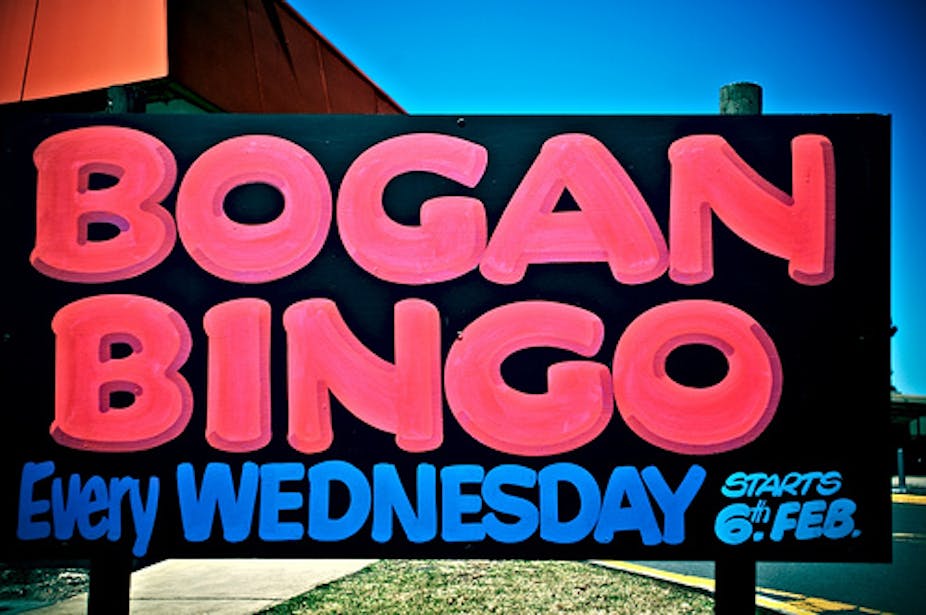
The first promotional interview for my new book The Bogan Delusion brought it home very strongly.
As the drivetime radio host in Perth and I chatted amiably about the superficial aspects of the possible meanings of the term “bogan” a listener SMSed him that if I thought the bogan was just a construct, I had “obviously never traveled on a plane to The Pilbara”.
Such a route was, of course, the province of the cashed-up bogan (CUB), a reckless spendthrift hooligan, paid too much to do unskilled work, the only attraction of which is wild west wages.
The angst generated by the mining boom in Australia’s west is for most citizens primarily centred around the knowledge that this continent is, in a booming echo of the 19th century, being wrung for its resources by local capitalists for the creation of another nation’s industrial and social development.
However, there is a second aspect to the boom which also resonates with (say) the gold rush, or the rise of the pastoral industry. That is the creation of a brand of worker specifically identified with the boom in question.
150 years ago, such workers were physically tested on a daily basis by their exertions be they for the possibility of massive wealth and the ongoing reality of very minor returns, or for low and/or seasonal wages in remote locations – or any number of similar stories of regional exploitation at the frontier.
Today, with mechnisation proven and predominant, and the lure of the city at such a cultural premium, mining “giants” have to (and can afford to) pull out the stops in offering very high wages to men and women “at the coalface”.
Here, perhaps, another historical period is more pertinent for comparison: the rise (or creation) of the teenager in the 1950s, with her or his disposable income and fickle recklessness. On the lookout for “kicks”, such monsters would form marauding tribes (for instance, bodgies) and menace decent people with petty antisocial crimes.
The “cashed up bogan” is not a new creation but a blend of previous fears: a rebooted horror movie franchise with superficial contexts updated. It takes the traditional bogey of the “bogan” – an imperfectly defined fringe figure prominent in humour and moral panics of the 21st century, particularly amongst people that could often be termed the elite – and adds in extra envy and fear.
The recent satirical publication Things Bogans Like will one day be seen as a fine snapshot of how, in the second decade of the 21st century, Australians of a certain background responded to the latest manifestation of working-class menace.
The many pseudonymous authors of this richly-illustrated work take on what they see as a vigorously ugly new phenomenon: not the innocent, reticent bogan of old – entranced by telly and quiet beer drinking – but the New Bogan obsessed with material culture and feeding parasitically from the cultural cast-offs of the elite.
Though dressed up in gags about tramp stamps and Boost Juice, the book revolves essentially around a highly conservative and almost puritan core of self-righteous finger-wagging.
Here, impulse-buying and an assumption that bigger must always be better creates an environmental and aesthetic nightmare known as the fringe housing estate: the new cashed-up bogan, it tells us, lives comfortably and wastefully in a “sprawling and inefficient housing estate on the urban fringe, subsidised by non-bogans.”
The final clause of this sentence is possibly the most disturbing evoking as it does somewhat similar kneejerk objections, common to shock-jocks and opposition spokesmen alike, to the misuse of “taxpayers’ money”.
Once again, I would posit, the underlying, unapologetically elitist outrage simmers that, while Australia is a democratic, capitalist (and therefore in large part consumer-directed) society, there is a significant section of the population who should not be trusted to make choices.
The cashed-up bogan – CUB – is too weak in mind or poor of education to understand how his/her financial choices affect her, or himself, and for that matter all Australians. The basic acronym evokes the cultural memory of Carlton and United Breweries, but is sometimes more affectionately expressed as the childish “cubby”.
The cubby story is still to play out. I would argue that, just as we need to problematise the bogan itself as a concept (criminal, blue-collar worker, devil, decent bloke/sheila… Australian or unAustralian?) we need to separate out our cashed-up bogans as a sub-group.
The mining-boom brand is a temporary phenomenon, yet very close to the teenager of sixty years ago, with no particular concern for tomorrow and excess energy to burn.
The eco-terrorist of Things Bogans Like is similarly in need of closer examination, a product perhaps of ongoing prosperity within a framework of state and federal governments desperately unwilling to prescribe day-to-day environmental awareness, and mindful of the Australian’s death-grip on home ownership as a life goal.
Is the cubby a myth? Well, as I discuss the bogan per se in my book, the word is almost always defined against its definer: everyone thinks they agree on the meaning of the term, but usually don’t.
However, there is a secondary point, better suited to the cubby: the idea that certain people deserve to be poor, and instead are flashing around bling more rightfully “ours”.
If all “we” have to express “our” unhappiness at this supposed injustice is our articulate verbosity, let’s at least take advantage of that and have the discussion at a slightly deeper level.

